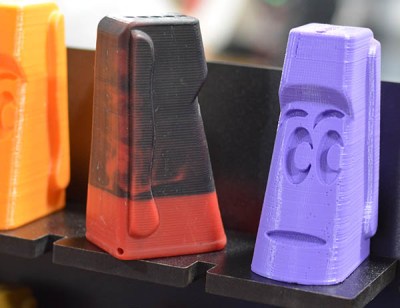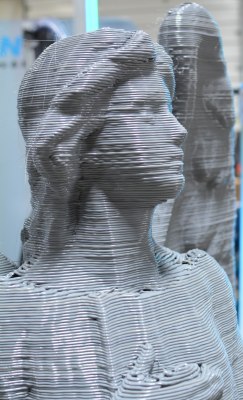Only a few days ago, a significant proportion of the Hackaday crew was leaving Goshen, Indiana after the fourth annual Midwest RepRap Festival. We go to a lot of events every year, and even when you include DEF CON, security conferences, ham swap meets, and Maker Faires, MRRF is still one of the best. The event itself is an odd mix of people rallying under a banner of open source hardware and dorks dorking around with 3D printer. It’s very casual, but you’re guaranteed to learn something from the hundreds of attendees.
Hundreds of people made the trek out to Goshen this year, and a lot of them brought a 3D printer. Most of these printers aren’t the kind you can buy at a Home Depot or from Amazon. These are customized machines that push the envelope of what consumer 3D printing technology. If you want to know what 3D printing will be like in two or three years, you only need to come to MRRF. It’s an incubator of great ideas, and a peek at what the future of 3D printing holds.
Resin Printing

Resin printing has been just over the horizon for several years now. Is it ready for prime time? You would think so, with Autodesk’s release of the Ember and the materials, hardware, toolchains, and machines quickly coming together into something that’s actually usable in a home, lab, or hackerspace. So, how well were resin printers represented at MRRF? Eh, not very well.
That’s not to say resin printers didn’t make an appearance. LittleRP was there showing off their printer and the very high quality prints it produces. There was a SeeMeCNC droplit, but it wasn’t in action. The Form 1+ was. This year, at least, resin printers were a curiosity. The prints coming out of these printers are great, but it doesn’t look like it’s ready for prime time quite yet.
Like fusion power, it seems desktop resin printing is perpetually a few years away. Two or three years from now, we’ll all have them on our desks. It’s the one prediction you can never go wrong with.
In Becoming A Swap Meet
Get enough hobbyists in one place, and you’ll eventually have a swap meet. That’s been the general idea behind hamfests, vintage computer conventions, and other miscellaneous conventions. MRRF is no different than any of these other festivals, and the pictures bear this out:
The Current State of 3D Printing
The Hype Cycle is a completely unscientific and only correct in retrospect observation on new technologies. It starts off with a trigger, and quickly accelerates to the peak of inflated expectations. For 3D printing, the peak of inflated expectations happened sometime around 2013 or 2014. 3D printed cars were the future, 3D printed apartment blocks existed, and soon we would have 3D printers on every desktop.
![[Prusa] brought over an i3. The i3 v2 was not on display.](https://hackaday.com/wp-content/uploads/2016/03/dsc_0162.jpg?w=347)
Technology improves, as well. [johnny r] of Ultimachine is working on an ARM-based version of the RAMBo, promising better prints and more capable hardware. There is word of an improved Prusa i3. A few years ago, you could count the number of filament manufacturers in the US on one hand. Today, there are a dozen.
What is the state of 3D printing? Improvement. Everything is improving, from slicers and software, to hardware and materials. MakerOS, soft-launched during last year’s MRRF and was out in full force demonstrating their new software for 3D printer businesses. Red Hat is actively contributing to the software stack. Lulzbot is iterating on the TAZ (and might be the largest manufacturer of personal 3D printers right now), and E3D is making a great case for dual extrusion printing and dissolvable materials. The future of 3D printing doesn’t exist yet, but at MRRF you can easily see where it is going – it’s only going to get bigger and better.
The PartDaddy

Since Goshen, Indiana is the home of SeeMeCNC, delta robots, especially SeeMeCNC’s Rostock Max, are especially well represented. While the Rostock Max is very big for a desktop 3D printer, SeeMeCNC does make an even larger printer – the PartDaddy. It’s a 16-foot-tall delta robot with a four foot diameter build plate. It’s huge, and SeeMeCNC will build you one for $90,000. It’s the greatest trade show demo you’ve ever seen.
The PartDaddy doesn’t use filament. Instead, the extruder was made out of the parts from an injection molding press. To extrude plastic through its 4mm nozzle, a small shop vac sucks natural PLA pellets and 2-3% masterbatch, or tiny colored beads, into a hopper. This is fed into the hot end via a screw, and is eventually extruded out of a nozzle that is highly evocative of the old RepRap acorn nut nozzles of 2010.
For this year’s MRRF, the PartDaddy printed the standard octopus, [whosawhatsis]’ gear bearing, and [mechg]’s “Single-Perimeter Rocket for Seamless Spiral Printing.” The rocket was obviously the star of the show, taking fifteen hours to print, starting late Saturday night and ending Sunday afternoon. The entire print was livestreamed, and thanks to the magic of a Dropcam, we have a time lapse of the rocket being printed and the last day of the festival. The completed print was scaled 15x in the x and y axes, 19x in the z axis, making it about nine feet tall.

















![Egg Chair PartDaddy printed egg chair, featuring Hackaday's own [Kristina]](https://i0.wp.com/hackaday.com/wp-content/uploads/2016/03/egg-chair.jpg?w=121&h=181&ssl=1)















like all tools, i think 3d printing has it’s place. however, it may be a mistake to think that it should be the only step in making objects. instead, i think that perhaps extrusion should be used to create the framework of an object and the extruder tool should be one several tools available. having tools like a drill for CNC and a laser for cutting (or possibly sintering) could be used to make more detailed models in less time with higher accuracy.
I agree! However, I keep seeing mentions of how you can’t turn a 3D printer into a CNC/Laser Cutter, and vice versa, without any explanation of why that’s the case. Is it an accuracy issue? I’d love to see a breakdown of the differences between the different types of 3D positioning systems and what it would take to convert one into another.
Same reason a normal drill makes a crappy router. The bearings are set up to handle pressure inline with the cutter/extruder, not to handle heavy side loading incurred during milling and routing.
Multifunction machines exist but there is often a compromise somewhere. If you can design for one task there’s less baggage from other tasks. A mill is heavy for heavy cutting, and that weight hurts performance needed for 3D printing, which you get better results with lighter mechanisms. Lasers are even more dependent on minimum weight. A 3D printer set up to mill might damage its frame, give a rough finish and get junk in the slides
I’ve been working on software to turn repraps into 3-axis mills. It’s currently functional, but I’m not ready for a public release yet as in bogged down working on the user interface. You can follow the project CNFR33D on hackaday.io
From Ultimaker here.
Why is it a bad idea?
CNC routers need strong stiff frames to absorb the impacts of the router bit impact on the material. 3D printers on the other hand need quick accurate movements with minimal slowdown. So heavy strong vs light quick. You can do strong & quick, but then it becomes expensive. So expensive that you might as well build 2 machines. (Or you’ll get a bad mill and/or a bad printer)
Lasers? Lasers need to be enclosed. Lasers are best served by a large X/Y area and Z isn’t that useful for them. Dust is their worst enemy, so combining it with a CNC router is a bad idea, even tough an router can also be served well by a large X/Y area. Combing it with a 3D printer could be done, but you will need to make odd compromises on build sizes. But it will be a complex design, as you need to keep a clear path for your laser in the design.
All that complexity to save cost on some motors and mechanics isn’t really worth it.
On a laser, your lasertube is your most expensive part (inc power supply)
On a router, your spindle is your most expensive part
On a 3D printer, electronics and hotends are your most expensive parts
(Not saying you cannot save costs on these, but in reality you shouldn’t)
I almost went. I was hoping for a gathering closer to Dayton Ohio.
The gathering is in Thornville. That’s an hour or so closer to Dayton than Goshen.
The Dayton http://www.hamvention.org is coming up…
They will probably be a 3D printer booth or two.
I drove over from Greenville. It’s not that bad of a drive. The bad part was driving home. I left Seeme’s offices around 11pm. Got home around 1.
I don’t see how Lulzbot can be the largest personal manufacturer, I’m pretty sure Makerbot and Ultimaker have that covered.
http://www.3ders.org/articles/20131106-open-source-3d-printers-challenge-giants-stratasys-and-3d-systems.html
Statistics can show a wrong image. 3D hubs started in Europe near Ultimaker HQ. Ultimaker has actively promoted them. So most likely they have a bias towards Ultimaker.
The 3D hubs statistics also only show the people that are “sharing” their printer. This is only a fraction of the market.
I think Ultimaker is (maybe) the biggest in Europe. And I think Lulzbot has most likely the largest turnover in the US, while Printrbot has most likely sold the most printers in the US.
(All based on gut feeling, and walking around at Ultimaker HQ)
Interesting in this statistics, they see a company named “RepRap” and also a printer model named “RepRap”.
Now, RepRap is a community, it doesn’t sell anything. There’s RepRapPro, a company founded by the same person.
Printer models shown in the RepRap community number somewhere in the 4-digit range. People are outright keen to create new models instead of building proven ones. If one takes RepRapPro, they have several models, including Ormerod and Fisher. And the gazillions of cheapo-chinese models appearing everywhere got apparently forgotten.
It looks a bit like these statistics makers don’t really know what they’re talking about.
FIX THIS: Click to embiggen.
Click to invigorate. There you go.
So I was at Mustang car show last weekend.
I over heard someone say “electric cars are perpetually a few years away”.
I told them they already exist and are quite popular.
They said, “None are being shown here today”.
I was close to mentioning there has never been an electric Mustang…. but I just walked away.
On a completely unrelated topic, when’s the resin based RepRap project start?
that is a great photo at the top of the close-up of the active extruder. props to the photographer!